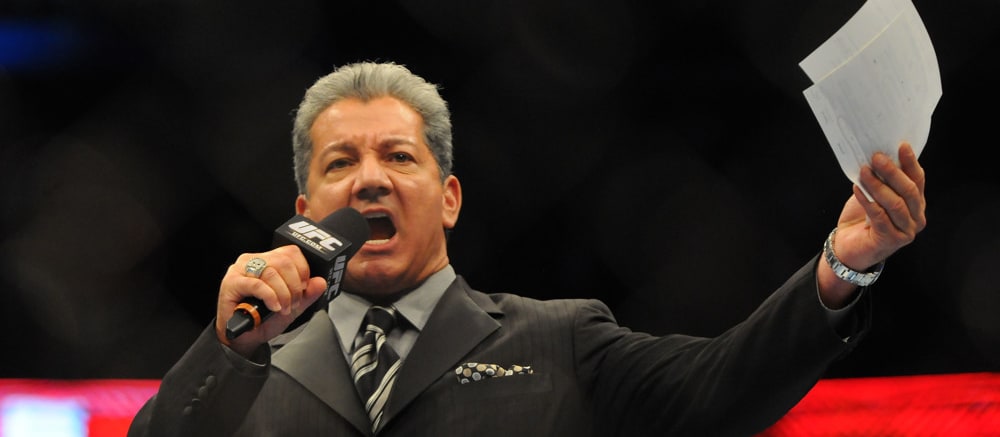At first glance, sinking your teeth into daily fantasy MMA (DFS MMA) may seem like a daunting task. Daily fantasy players who enjoy building lineups for traditional team sports may bristle at the thought of trying to conquer slates in an environment where the research is based more on viewing actual fights than relying on stats, and which uses a scoring system that may seem strange to the uninitiated.
Despite these differences, the fundamentals of DFS remain the same. Aspects such as roster construction, how to strategize for different kinds of tournaments and how to manage your bankroll are all integral parts of being successful at MMA DFS. In this column, I will go over a few sound strategies for these and other topics that even a newcomer can use in order to get their hand raised at the end of the night.
But first, here's a quick rundown of the MMA stats that are used, along with their associated point values...
Moves Scoring
Significant Strikes (SS): +0.5 PTS
Advance (ADVC): +3 PT
Takedown (TD): +5 PTS
Reversal/Sweep (REV): +5 PTS
Knockdown (KD): +10 PTS
Fight Conclusion Bonuses
1st Round Win (1rW+): +90 PTS
2nd Round Win (2rW+): +70 PTS
3rd Round Win (3rW+): +45 PTS
4th Round Win (4rW+): +40 PTS
5th Round Win (5rW+): +40 PTS
Decision Win (WBD+): +30 PTS
Scoring Notes
Significant Strikes are any Distance Strike or Clinch/Ground Strikes that are considered "Power Strikes" by official scorers.Advances include: To Half Guard, To Side Control, To Mount, To Back Control.
As with any DFS game, learning to win means focusing on where we get the most points. Players can use the above index as a reference as we go through the sections of this article in order to help determine which kinds of fighters make for the best selections.
1. Strikers versus Grapplers
A layman could certainly be forgiven for thinking that strikers are the way to DraftKings gold. After all, strikes will add up over the course of a fight, and the biggest single point total for a given action is a knockdown (10) which is more likely to be delivered by someone who makes their money on the feet. The thing to keep in mind here is that knockdowns are relatively difficult to come by, particularly in lighter weight classes. We must also note that large chunks of a fight can take place against the fence or on the ground, where delivered strikes are less likely to be considered significant.
By contrast, a strong wrestler can easily get one or two takedowns per round if necessary. This can either lead to a finish, which is the ultimate goal, or transitions into more dominant positions on the ground, which nets us an additional three points.
For a clear picture of how a dominant wrestler can pile up the points, we need only look at Edmen Shahbazyan, a fighter on the prelims of the upcoming UFC 239 card. Shahbazyan secured eight takedowns and three advancements in his win over Darren Stewart in his UFC debut, which netted him 90 points, despite only landing 22 significant strikes. Consider that a kickboxer would need to land 120 significant strikes in a win to equal that total, and you really get a feel for how valuable grappling can be.
This doesn't mean you should choose wrestlers, exclusively, however. Instead, look for mat rats against opponents with shoddy takedown defense and strikers with solid takedown defense against those who primarily grapple, as they are vulnerable to eating big shots if they can't get the fight to the floor.
2. GPP vs. Cash Games
A very common dynamic you will hear bandied about when discussing how to approach GPP and cash games is that of ceiling versus floor. This concept is a bit murkier in MMA than it may be in other sports, as we don't really have elements in place (number of touches, time on the floor, number of at-bats) that can control the potential a competitor has for scoring points. Having said that, we can still make reasonable assumptions as to where a fighter belongs based on what they bring to the cage.
If a fighter has knockout power but not much else, we can say that he or she is a GPP option because we are expecting that fighter will either get a KO (and thus, big points) or lose the fight. Similarly, we can determine a fighter's floor based on how many point scoring opportunities they have. If a fighter is a dedicated wrestler, strikes in high volume, or is difficult to finish, we may reason that they are options because they can leave us in a decent position even if they don't win, making them a more justifiable play in cash formats. 'Safety' remains a bit of a nebulous idea in a sport where the event can end with one punch, but by understanding how fighters score points, we can try to determine whether they are more suitable for cash or GPP lineups.
Once we determine that, there is still a question of which kinds of contests fall into which category. Take qualifier and satellite tournaments, for example. These will typically be contests that award prizes to a very small fraction of entrants. This means that we need to do what we can to get above the field, which likely entails taking more risks to accrue the most possible points.
3. Bankroll Management
There is often debate in DFS circles regarding how much salary is the maximum amount that should be left on the table when constructing a lineup. Generally, this number isn't more than a few hundred dollars. The reason behind this is a logical one, as more expensive players are generally considered more likely to score points, so it doesn't make sense to pass on too many players if you have the money.
This sentiment doesn't really apply to MMA, however, for the precise reason I mentioned in the last section. Since there are no factors in the sport that naturally result in greater point totals, the only real decision a prospective owner needs to make is which fighters have the best matchups. Thus, it's not uncommon to hear of a player leaving upwards of $1,000 dollars on the table in a GPP on a given slate. While this will always be slate dependent, it's important to not get trapped into feeling like you have to spend all of the money allotted to you.
This doesn't mean you never want to pay up for fighters, of course. Significant skill or high-level experience discrepancies are likely to be a bit more prevalent in the higher ranges. It's important to remember, though, that lines are sometimes set on fighters from lesser organizations based on record or reputation, which is where tape study can make all the difference.
4. Strategy for Multi-entry contests
Contests like the "239 Special" registering for UFC 239 will always get multiple entries, with people like my fellow Fight IQ podcast analyst Joe (@suntszu) sometimes putting in more than 100 lineups in a given GPP. How do we go about entering multiple lineups? The first thing you want to do is make a spreadsheet that documents which fighter(s) are on which teams. I would strongly caution against trying to do this freehand, as it's easy to forget which fighters were put in which lineups, which can lead to not getting your desired percentages.
How do we determine the appropriate fighter percentages? One simple way to do this is to load up on fighters (and fights) you see getting finishes, which as we see from the scoring chart above, carry large bonuses. Aside from watching tape, we can attempt to sniff this out by looking at things such as "fight does not go to decision" and "fight starts Round 2" props. We can also try and feel for the pulse of the field before the event. If we see a popular/historically high scoring fighter on the card who we think has a tough matchup, we can either choose to lessen our exposure to that fighter or go heavier on their opponent, as we will gain a good amount of leverage on the field if and when they lose.
5. Which Contest is Right For you?
Deciding which kind of contest to enter hinges on what your intended goal is in playing. Want to go for the big money with minimum risk? A $1-8 GPP is likely for you. It must be noted that these contests can hold upwards of 30,000 players, however, meaning you will miss a lot more than you hit. If you are trying to build a bankroll, however, contests with fewer players/more paid spots will always be the way to go. No matter what kind of contest you decide on, however, RotoWire's revamped lineup optimizer can help you get the job done. Unveiled shortly before UFC 239, this new optimizer can not only help with your lineup builds but also give you implied win percentages based on money lines, and provide you with key statistics like height and reach measurements. With so many resources available, players need only decide which contest to play before taking the steps to succeed.












